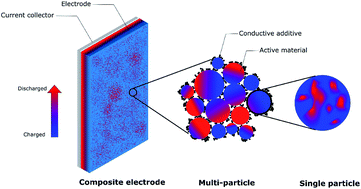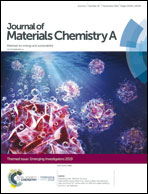Probing and quantifying cathode charge heterogeneity in Li ion batteries†
Abstract
Increasing the energy density and cycle life has been a continuing effort to improve lithium ion batteries. Beyond designing new materials, improving the utilization of current materials is a critical step towards this effort. Due to the heterogeneous nature of the battery materials and electrodes, the redox reactions take place non-uniformly at all length scales ranging from single particles, to multiple particles, and to battery electrodes. Such non-uniformity, often called charge heterogeneity, negatively impacts the battery performance. Significant efforts have been made to homogenize the charge distribution at all length scales to eliminate the local over-charge or over-discharge, and to improve the contribution of individual active particles to the overall capacity. The multiscale charge heterogeneity can be caused by many factors, including the intrinsic properties of battery particles, battery electrode formulation, electrochemical protocols, and external environment such as temperature. In this review, we provide a comprehensive discussion of the current research frontier in probing and quantifying the charge heterogeneity in intercalating lithium ion cathode materials and electrodes. First, we discuss the particle-level charge heterogeneity. The charge heterogeneity at this length scale is associated with ion reaction mechanisms such as solid solution and phase separation, structural defects such as grain boundaries, and morphological features such as facet termination. Second, we discuss the electrode-level heterogeneity that is mostly influenced by the electrode characteristics such as electrode porosity and tortuosity. These characteristics determine the ion and electron conducting pathways, which is the underlying mechanism for governing the redox propagation in electrodes. Third, the review also provides an in-depth analysis of the factors that govern the charge heterogeneity and summarizes the current efforts to eliminate the heterogeneity. Last but not least, studying the charge heterogeneity involves the use of advanced spectroscopic imaging techniques; thus we also discuss the working principles of these techniques throughout the review. In summary, the review highlights how the charge heterogeneity is probed and quantified using various sample environments and sheds light on the potential methods to mitigate or even eliminate the charge heterogeneity for improving battery performance.

- This article is part of the themed collections: Recent Review Articles and Journal of Materials Chemistry A Emerging Investigators


 Please wait while we load your content...
Please wait while we load your content...